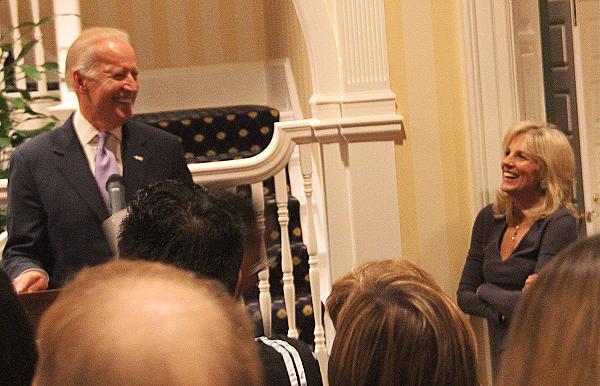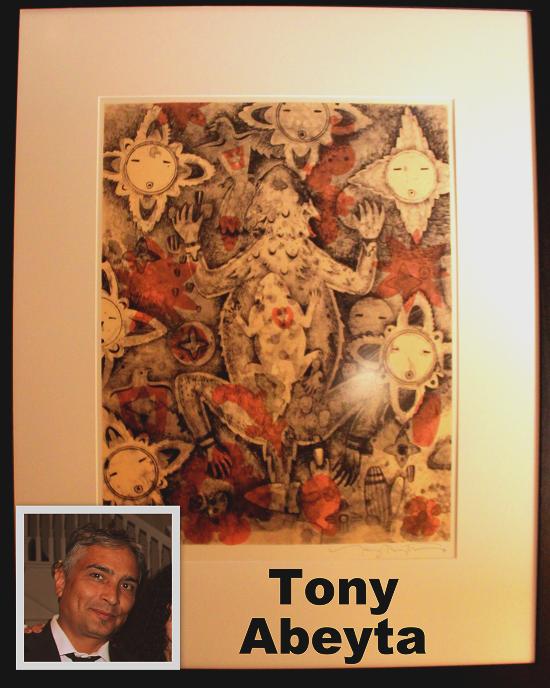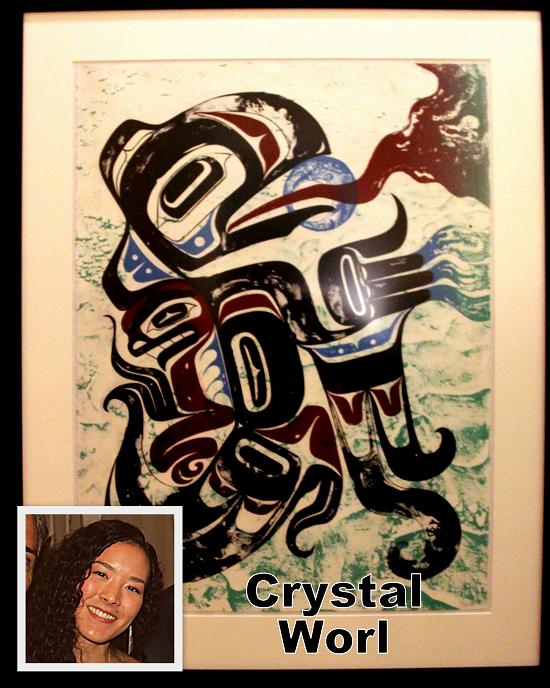 |
Canku Ota
|
 |
|
(Many Paths)
|
||
|
An Online Newsletter
Celebrating Native America
|
||
|
November 2015 - Volume
13 Number 11
|
||
|
|
||
|
Dr. Jill Biden And
Vice President Biden Honor 5 Native Artists At The VP's Home
|
||
|
by Vincent Schilling
- Indian Country Today Media Network
|
||
|
credits: (all photos
by Vincent Schilling - Indian Country Today Media Network)
|
|
Vice President Joe Biden and his wife, Dr. Jill Biden, honored five Native American and Alaskan Native artists last night in a reception at their home in Washington DC. In addition to honoring the artists, the Bidens displayed a framed print from each of the artists on the walls of their foyer and living room.
The reception was in honor of artists Tony Abeyta (Navajo), Crystal Worl (Tlingit Athabascan), Jeff Kahm (Plains Cree), Courtney Leonard (Shinnecock Nation) and Dan Namingha (Tewa-Hopi) as well as a celebration of a collaboration between the U.S. Department of State’s Office of Art in Embassies (AIE) and the Institute of American Indian Arts (IAIA). The five artists were commissioned by the AIE and IAIA to create 10 pieces of art each, that will be exhibited at U.S. diplomatic facilities around the world. Dr. Biden was the first to address the approximately 100 guests. “Your artwork represents rich and vibrant cultures that have thrived on this continent for a millennium, every color, shape and stroke on the canvas brings to life a connection with your roots and your ancestors,” she said. When Dr. Biden added with a smile, “There is an old adage that says art outlives politics,” the room erupted with laughter and applause. Both AIE Director Ellen Susman and IAIA President Robert Martin lauded the efforts of the artists and expressed appreciation for a successful collaboration between the two agencies. After addressing the room, Martin presented a blanket to Dr. Jill Biden and then introduced the Vice President. Vice President Biden first joked that now that Dr. Biden had a warm blanket, "She won't need me anymore," causing the crowd to laugh and applaud.
Biden welcomed the crowd and applauded the artists. He spoke of how he traveled the world and in over a million miles of travel hears more about Indian arts and culture than anything else. "The one thing I think Jill enjoys most about this job is the opportunity every six or eight weeks to change the art. It has been a joy," he said. The Vice President expressed his appreciation for the artwork created by the artists and the importance of tribal relations to the Obama administration. "Barack and I have tried very hard to strengthen the nation's through tribal sovereignty," said Biden. Biden also mentioned his efforts to bring awareness to the importance of climate change to Indian Nations, the importance of the Affordable Care Act and of the Violence Against Women Act. "I hope we are doing something to make up for a century of not-so-good stewardship," he said. Biden then thanked the largely Native audience for the "very richness of Native American culture. Thanks for enriching our lives.” Courtesy of the U.S. Department of State’s Office of Art in Embassies (AIE), here are biographies of the five artists as well as the art that is now displayed at the Vice President’s home: Tony Abeyta (Navajo):
Tony Abeyta is a contemporary Navajo artist working in mixed media painting. He is a graduate of New York University with an honorary doctorate from the Institute of American Indian Arts, Santa Fe, New Mexico. He currently works in both Santa Fe and Berkeley, California. Tony was the 2012 recipient of the New Mexico Governor’s Excellence in the Arts award, and was recognized as a Native Treasure by the Museum of Indian Arts and Culture. His work is included in the Smithsonian’s National Museum of the American Indian (Washington, D.C.), Boston Museum of Fine Arts (Massachusetts), the Heard Museum(Phoenix, Arizona), New Mexico Fine Arts Museum (Albuquerque), the Autry Museum (Los Angeles, California), and the Eiteljorg Museum (Indianapolis, Indiana), as well as in many other public and private collections. Tony Abeyta’s primary focus has been on painting the emotional experience one finds in the New Mexico landscape. “There exists a rhythm in the land where I was born. I spend a lot of time deciphering the light, the cascades of mesas into canyons, the marriage between earth and sky and the light as it constantly changes at whim, the intensity of rock formations, and the sage and chamisa that accent this poetic experience, unlike anywhere else I have seen. I am beckoned to remember it and then to paint it.” Crystal Worl (Tlingit Athabascan):
Crystal Worl is a Tlingit Athabascan artist who makes art because she wants to remind those who have left home that they come from a special place. Her family and community have guided her to learn, work, and live for her community. Her practice in storytelling and art comes from the values and lessons of the Tlingit people and her family. Crystal works in jewelry, metals, printmaking, kiln-cast glass, and painting. The forms on which she focuses are based on traditional Tlingit form and line, also known as Northwest Coast design. She practices the recreation and modernization of her Clan’s crest, the Lukaahadi (Sockeye, Raven Clan). Crystal utilizes her education to apply new techniques and ways of presenting traditional designs and stories. Her most recent work explores Tlingit design, intertwined with stylized Athabascan beadwork patters. Crystal Worl was introduced at a young age to traditional arts, practices, and storytelling. In May 2013 she earned her Bachelor of Fine Arts degree in studio arts from the Institute of American Indian Arts, Santa Fe, New Mexico, from which she also obtained her Associate in Fine Arts degree in moving images. Jeff Kahm (Plains Cree):
Jeff Kahm is an associate professor at IAIA where he teaches studio art courses at the intermediate and advanced levels. As an artist, Jeff creates work in his Santa Fe studio. His solo exhibitions at the Museum of Contemporary Native Arts in Santa Fe (2012), and at Urban Shaman Contemporary Aboriginal Art in Winnipeg, Manitoba (2013), highlighted his most recent work – a striking series of small works on paper and panels and an impressive collection of large scale paintings on canvas, which he describes as “rooted in Indigenous abstraction and Modernist aesthetics.” His work continues to reach a wider audience through various invitational and group shows, nationally and internationally. Jeff Kahm, Plains Cree, was born in Edmonton, Alberta, Canada and was raised on the Little Pine First Nation in Saskatchewan. After completing high school, he attended the Institute of American Indian Arts (Santa Fe, New Mexico) to pursue painting and photography. Soon thereafter he was awarded a painting scholarship from the Kansas City Art Institute (Kansas), which allowed him to pursue undergraduate studies and to earn a Bachelor of Fine Arts degree in 1994. Jeff also studied at the University of Alberta, earning a Master of Fine Arts degree in 1997. In 2002 Jeff returned to New Mexico, a land that he has grown to love and that he now calls home. He became a permanent resident in 2003, and soon began teaching at the Institute of American Indian Arts (IAIA) as a visiting faculty member. Courtney Leonard (Shinnecock Nation):
A member of the Shinnecock Nation of Long Island, New York, Courtney Michele Leonard’s artwork explores the evolution of language, image, and culture through mixed media pieces of video, audio, and tangible objects. Her current work embodies the multiple definitions of Breach, an exploration and documentation of historical ties to water, whale, and material sustainability. Courtney’s solo exhibition entitled BREACH: LOG 15 was recently held at the University of the Ozarks (Clarksville, Arkansas) and the IAIA Museum of Contemporary Native Arts (Santa Fe), with research in collaboration with indigenous artists from Aotearoa and Nova Scotia. Courtney has given lectures and exhibited nationally and internationally, most recently at Toi Ngaphui Northland College (New Zealand), the Museum of Art and Design (New York City), Museum of Contemporary Native Arts (Santa Fe), Eastern Connecticut University (Willimantic), Tribeca Film Institute (New York City), National Museum of the American Indian (Washington, D.C.), University of the Creative Arts Farnham (England), and the University of Rostock (Germany). She currently lives in Santa Fe, and works as a professional artist, lecturer, and visiting assistant professor in studio arts at the Institute of American Indian Arts. She studied art and museum studies at the Institute of American Indian Arts (Santa Fe, New Mexico; Associate of Fine Arts degree), Alfred University (New York; Bachelor of Fine Arts degree), and the Rhode Island School of Design (Providence, Rhode Island; Master of Fine Arts degree). Dan Namingha (Tewa-Hopi):
Dan Namingha is from the Tewa-Hopi tribe, and he works in a broad variety of media, including paintings, sculpture, and collage. His artistic journey has led him to combine his personal ideas and memories with the symbolism of his Hopi-Tewa culture, to translate the powerful geography of the Southwest through formal concepts of modern art and composition. His work often draws on the sacred traditions of his culture, which are so deeply embedded in ceremony. Dan’s work commands unwavering respect for the earth and spirit of his ancestry. Dan’s formal study took him to the University of Kansas (Lawrence), the American Academy of Art (Chicago, Illinois), and the Institute of American Indian Arts (Santa Fe, New Mexico), from which he received an Honorary Doctorate degree in 2009. Dan Namingha has exhibited in dozens of one-man shows and many more group exhibitions, and his work hangs in more than thirty major institutions, including the Smithsonian Institution (Washington, D.C.), the Sundance Institute, the Heard Museum (Phoenix, Arizona), the British Royal Collection (London, England), and other museums worldwide. He has received awards from the Harvard Foundation and the Fogg Art Museum (Cambridge, Massachusetts), as well as the Visionary Award from the Institute of American Indian Arts Foundation. His work has toured Europe as part of an exhibition sponsored by the United States Information Agency and is found in several U.S. embassies. Dan Namingha is the subject of several film documentaries, and his work in held in numerous collections worldwide. |
|||||||||
|
|
|
|
||
|
|
||
| Canku Ota is a free Newsletter celebrating Native America, its traditions and accomplishments . We do not provide subscriber or visitor names to anyone. Some articles presented in Canku Ota may contain copyright material. We have received appropriate permissions for republishing any articles. Material appearing here is distributed without profit or monetary gain to those who have expressed an interest. This is in accordance with Title 17 U.S.C. Section 107. | ||
|
Canku Ota is a copyright ©
2000 - 2015 of Vicki Williams Barry and Paul Barry.
|
||
 |
 |
|
|
The "Canku
Ota - A Newsletter Celebrating Native America" web site and
its design is the
|
||
|
Copyright ©
1999 - 2015 of Paul C. Barry.
|
||
|
All Rights Reserved.
|
||






